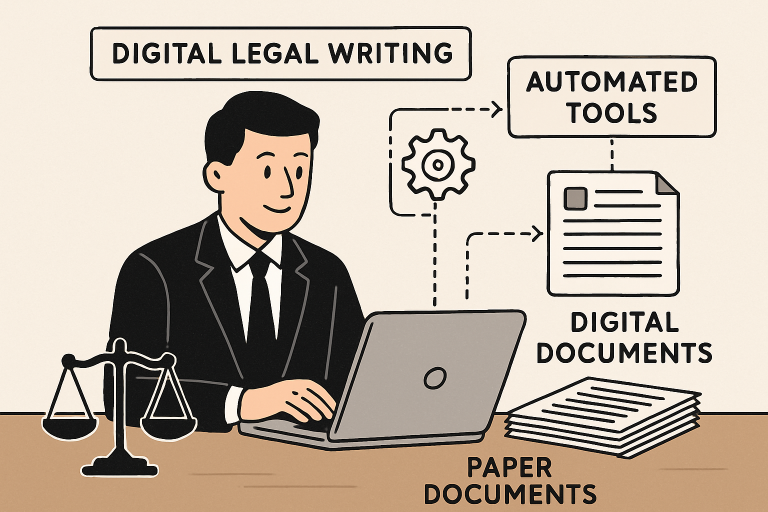Key Takeaways
- Legal writing tools are streamlining the workflow for attorneys, saving valuable time.
- Technology is increasing accuracy and reducing human error in legal documentation.
- Attorneys can now access rapid research and drafting resources, influencing outcomes across the case lifecycle.
- Staying current with advancements in legal tech is becoming essential for today’s successful practitioners.
- Ethical considerations and best practices must accompany technological adoption in law offices.
Table of Contents
- Technology Trends Reshaping Legal Writing
- Key Benefits for Attorneys in Adopting Fast-Turn Legal Tools
- Impact on Case Lifecycle: From Research to Resolution
- Real-World Examples of Improved Outcomes
- Overcoming Challenges in Tech Adoption
- Future Outlook for Legal Technologies
- Ethical Considerations in Automated Legal Writing
- Conclusion: Embracing Evolution in Legal Practice
Technology Trends Reshaping Legal Writing
Legal writing, once a time-consuming and painstaking process, is undergoing a dramatic transformation. Artificial intelligence (AI), automation platforms, and advanced data analytics are now helping law firms boost productivity and reduce errors, as the New York Times outlined. Forward-thinking platforms like tavrn.ai support attorneys with intelligent drafting, research acceleration, and document review tools, empowering practitioners to work smarter and deliver results faster.
As client demands grow and case complexities rise, legal professionals must adopt quick and accurate solutions. Modern writing technologies integrate seamlessly with case management systems, helping lawyers focus on core advocacy while automating repetitive documentation tasks. This evolution has freed up valuable bandwidth, allowing firms to devote more time to strategy and personalized client service.
Key Benefits for Attorneys in Adopting Fast-Turn Legal Tools
The migration toward intelligent tools is ushering in several critical benefits for legal teams. By reducing the need for repetitive manual drafting, legal writing platforms help lawyers maximize billable hours, avoid burnout, and ensure a greater focus on high-value work such as legal analysis and negotiation. These platforms can swiftly synthesize precedent, statutes, and relevant authority, pinpointing the most compelling arguments for a given case.
Additionally, increased documentation accuracy reduces the likelihood of costly errors. Many platforms feature built-in error-checking, citation validation, and collaborative capabilities to promote team transparency and consistency. These features collectively improve the attorney experience and contribute to stronger case outcomes.
Impact on Case Lifecycle: From Research to Resolution
Legal tech now touches every stage of the case lifecycle, from intake through litigation, settlement, or trial. With workflow automation embedded in research, drafting, and client communication, law firms are enhancing their overall agility. Tools can extract key facts, uncover precedential insights, and suggest optimized case strategies within minutes instead of hours. Recent reporting in the ABA Journal highlights how AI-driven research and drafting capabilities have increased client satisfaction and streamlined case management across diverse practice areas.
This new synergy between technology and legal practice fosters improved communication, faster turnaround on deliverables, and a more satisfying client experience. Whether developing case theories or responding to court motions, attorneys armed with contemporary tools move confidently and efficiently from research through resolution.
Real-World Examples of Improved Outcomes
Firms that have embraced legal writing automation consistently report stronger business performance and client outcomes. A midsize law practice that migrated to AI-assisted writing and research platforms dramatically reduced its average brief turnaround from several days to a few hours. Partners observed a significant jump in the clarity and consistency of filings, which elevated client trust.
Industry surveys mirror these observations, showing that most legal teams using AI solutions report higher morale, fewer late nights, and an increased capacity to accept new business. Enhanced client communications and rapid response times are now decisive competitive advantages.
Overcoming Challenges in Tech Adoption
- Training: Ongoing and accessible training is critical for ensuring all team members effectively use new tools. Firms often invest in workshops and hands-on demos to flatten the learning curve and promote universal adoption.
- Data Security: Sensitive legal data is a prime target for cyber threats. Robust end-to-end encryption and strict access controls must be prioritized to maintain client confidentiality and meet regulatory requirements.
- Change Management: Transitioning from traditional workflows requires a culture of innovation and buy-in at every level of the organization. Open dialogue, flexibility, and support from firm leadership are essential in facilitating seamless technology implementation.
Future Outlook for Legal Technologies
The coming years promise further leaps forward in legal technology. Expect platforms to introduce more advanced natural language processing, predictive analytics, and comprehensive workflow automation. Law schools are integrating legal technology into their core curriculum, preparing the next generation to operate at the intersection of law and digital innovation. Professional organizations also offer continued education and certifications, signaling how crucial tech fluency is for legal success.
As legal technologies mature, widespread collaboration between tech innovators and legal professionals is anticipated, resulting in even more intuitive and cost-effective tools. This evolution will ensure that attorneys remain effective advocates in an increasingly competitive and digitized landscape.
Ethical Considerations in Automated Legal Writing
With the adoption of AI and automation comes increased scrutiny of professional ethics. Attorneys must vigilantly safeguard client-attorney privilege and ensure the authenticity of all legal documents. Regular oversight of automated outputs is paramount—technology should serve as an aid, not a substitute, for legal judgment. The American Bar Association advises continuing education and diligent vetting of technology vendors to maintain the high standards of the legal profession.
Conclusion: Embracing Evolution in Legal Practice
Legal writing is undergoing a profound transformation, driven by the rapid development of advanced technologies designed to streamline complex tasks. The thoughtful adoption of these tools offers attorneys the opportunity to elevate their practice by improving efficiency, enhancing accuracy, and maintaining high ethical standards. By leveraging platforms like tavrn.ai, legal professionals can simplify repetitive drafting, minimize errors, and dedicate more time to client advocacy and strategic casework. This balance between innovation and responsibility ensures stronger outcomes for clients and greater adaptability in a competitive market. Those who embrace these advancements will lead the way as technology reshapes the very foundation of modern legal practice.
YOU MAY ALSO LIKE: Kennedy Funding Ripoff Report: Lender Disputes Explained

